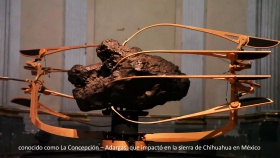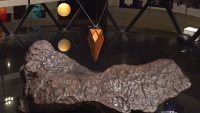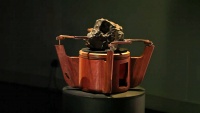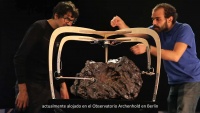(Unless otherwise stated, the copyright of the materials included belong to Jan Woreczko & Wadi.)
SIDERAL (projekt muzyczny)
Z Wiki.Meteoritica.pl
m |
|||
| Linia 3: | Linia 3: | ||
{{Strona w budowie}} | {{Strona w budowie}} | ||
| - | + | [[Image:SIDERAL_(Chupaderos)-1.jpg|thumb|right|280px|Meteoryt '''Chupaderos'''<ref name="Chupaderos"></ref> <br />(''Concepción-Adargas'')]] | |
{{Sparse-b}}Hasło powstało z inicjatywy [[Wikitariusz|Anny Siekierskiej]].{{Sparse-e}} | {{Sparse-b}}Hasło powstało z inicjatywy [[Wikitariusz|Anny Siekierskiej]].{{Sparse-e}} | ||
| - | Nazwa projektu '''SIDERAL''' to po hiszpańsku – gwiezdny, kosmiczny (np. ''el espacio sideral'' – przestrzeń kosmiczna). | + | Projekt '''SIDERAL''' został opracowany przez dwójkę latynoskich artystów Marcela Armas i Gilberto Esparza, jako kontynuacja cyklu '''rzeźb elektrofonicznych'''. Stworzyli oni prototyp instrumentu, który dokonuje odczytu lokalnego pola magnetycznego na powierzchni meteorytu i konwertuje zmierzony sygnał na dźwięki. Nie jest dokonywana bezpośrednia konwersja na dźwięki, ale parametry pola magnetycznego służą do modulacji parametrów (przestrzenność, częstotliwość, wysokość, rytm) zadanej kompozycji muzycznej. Na przykład w projekcie ''Concepción-Adargas'' wykorzystano muzykę rdzennej ludności Tarahumara z regionu Chihuahua.<ref name="Tarahumara"></ref> Nazwa projektu '''SIDERAL''' to po hiszpańsku – gwiezdny, kosmiczny (np. ''el espacio sideral'' – przestrzeń kosmiczna). |
| - | Obiektami eksperymentów (koncertów?) były meteoryty: '''Bacubirito'''<ref>okaz meteorytu żelaznego '''{{Link-MBD|code=4919|name=Bacubirito}}''' typu Iron-ung o wadze około 22 ton w zbiorach ''Culiacan, Sinalao, Centro Civico Constitution'' w Meksyku</ref>, '''Boxhole'''{{MBD-record|name=Boxhole}} (okaz 82,3 kg ze zbiorów [[Szablon:LondonNHM|Muzeum Historii Naturalnej w Londynie]]), '''Canyon Diablo'''{{MBD-record|name=Canyon Diablo}} (okaz 283,5 kg ze zbiorów ''Berlin, Archenhold Sternwarte'') oraz ponad 3 tonowy okaz meteorytu '''Chupaderos'''<ref name="Chupaderos"></ref>. | + | Obiektami eksperymentów (koncertów?) były meteoryty: '''Bacubirito'''<ref name="Bacubirito">okaz meteorytu żelaznego '''{{Link-MBD|code=4919|name=Bacubirito}}''' typu Iron-ung o wadze około 22 ton w zbiorach ''Culiacan, Sinalao, Centro Civico Constitution'' w Meksyku</ref>, '''Boxhole'''{{MBD-record|name=Boxhole}} (okaz 82,3 kg ze zbiorów [[Szablon:LondonNHM|Muzeum Historii Naturalnej w Londynie]]), '''Canyon Diablo'''{{MBD-record|name=Canyon Diablo}} (okaz 283,5 kg ze zbiorów ''Berlin, Archenhold Sternwarte'') oraz ponad 3 tonowy okaz meteorytu '''Chupaderos'''<ref name="Chupaderos"></ref>. |
Opis projektu (źródło: YouTube): | Opis projektu (źródło: YouTube): | ||
| Linia 24: | Linia 24: | ||
La Concepción o Adargas, es un meteorito metálico de 3.3 toneladas que fue transportado de la Sierra de Adargas cercana a Huejuquilla (Jiménez, Chihuahua) el 29 de abril de 1780 hacia la cercana Hacienda de La Concepción.<ref name="Chupaderos">okaz meteorytu żelaznego '''{{Link-MBD|code=5363|name=Chupaderos}}''' typu IIIAB o wadze 3,325 ton (masa o nazwie Adargas) w zbiorach ''[[Meteoryty/Kolekcje|Mexico, Mexico City]], The Old School of Mines and Engineering (Palazzo de Mineria)''; tam też w kolekcji m.in. większe okazy tego meteorytu: Chupaderos I (14,114 ton) i Chupaderos II (6,767 ton)</ref> El Instituto de Astronomía de la UNAM<ref>Instituto de Astronomia Universidad Nacional Autonoma de Mexico, ''Mexico City, National Observatory''</ref> tiene su custodia desde 1976. Después de 40 años, este meteorito es removido del vestíbulo del Instituto, para ser trasladado temporalmente a la Capilla del Señor de Santa Teresa en el Museo Ex Teresa Arte Actual en Ciudad de México.<ref>'''Ex Teresa Arte Actual''' – muzeum znajdujące się w historycznym centrum Mexico City (Wikipedia)</ref> | La Concepción o Adargas, es un meteorito metálico de 3.3 toneladas que fue transportado de la Sierra de Adargas cercana a Huejuquilla (Jiménez, Chihuahua) el 29 de abril de 1780 hacia la cercana Hacienda de La Concepción.<ref name="Chupaderos">okaz meteorytu żelaznego '''{{Link-MBD|code=5363|name=Chupaderos}}''' typu IIIAB o wadze 3,325 ton (masa o nazwie Adargas) w zbiorach ''[[Meteoryty/Kolekcje|Mexico, Mexico City]], The Old School of Mines and Engineering (Palazzo de Mineria)''; tam też w kolekcji m.in. większe okazy tego meteorytu: Chupaderos I (14,114 ton) i Chupaderos II (6,767 ton)</ref> El Instituto de Astronomía de la UNAM<ref>Instituto de Astronomia Universidad Nacional Autonoma de Mexico, ''Mexico City, National Observatory''</ref> tiene su custodia desde 1976. Después de 40 años, este meteorito es removido del vestíbulo del Instituto, para ser trasladado temporalmente a la Capilla del Señor de Santa Teresa en el Museo Ex Teresa Arte Actual en Ciudad de México.<ref>'''Ex Teresa Arte Actual''' – muzeum znajdujące się w historycznym centrum Mexico City (Wikipedia)</ref> | ||
| - | Construimos el primer prototipo de un instrumento que realiza lecturas de intensidades del campo magnético local de la superficie del meteorito. La información obtenida en forma de una señal variable, es convertida a sonido tomando como referencia la sonoridad del lugar donde el meteorito impactó: voces de sintetizador que refieren a los sonidos percutivos de rituales rarámuris<ref>'''Tarahumara''', '''Rarámuri''' – lud zamieszkujący stan Chihuahua w Meksyku; jego członkowie słyną z niezwykłej wytrzymałości w biegu (Wikipedia)</ref>, se unen a sutiles expresiones inspiradas en el paisaje sonoro de la Sierra de Adargas en Jimenez, Chihuahua. Un gesto que conecta el espacio sideral y las manifestaciones de la vida en la Tierra. | + | Construimos el primer prototipo de un instrumento que realiza lecturas de intensidades del campo magnético local de la superficie del meteorito. La información obtenida en forma de una señal variable, es convertida a sonido tomando como referencia la sonoridad del lugar donde el meteorito impactó: voces de sintetizador que refieren a los sonidos percutivos de rituales rarámuris<ref name="Tarahumara">'''Tarahumara''', '''Rarámuri''' – lud zamieszkujący stan Chihuahua w Meksyku; jego członkowie słyną z niezwykłej wytrzymałości w biegu (Wikipedia)</ref>, se unen a sutiles expresiones inspiradas en el paisaje sonoro de la Sierra de Adargas en Jimenez, Chihuahua. Un gesto que conecta el espacio sideral y las manifestaciones de la vida en la Tierra. |
{{BQuote-end}} | {{BQuote-end}} | ||
| + | Efekty projektu są bardzo ciekawe i miłe dla ucha. | ||
== Galerie == | == Galerie == | ||
| + | |||
| + | Meteorytu wykorzystane w projekcie SIDERAL (źródło: YouTube) | ||
| + | <gallery caption="" widths="200px" heights="120px" perrow="3"> | ||
| + | File:SIDERAL_(Bacubirito)-1.jpg|Meteoryt '''Bacubirito'''<ref name="Bacubirito"></ref> | ||
| + | File:SIDERAL_(Boxhole)-2.jpg|Meteoryt '''Boxhole'''{{MBD-record|name=Boxhole}} | ||
| + | File:SIDERAL_(Canyon_Diablo)-2.jpg|Meteoryt '''Canyon Diablo'''{{MBD-record|name=Canyon Diablo}} | ||
| + | </gallery> | ||
| + | |||
=== Media === | === Media === | ||
| Linia 41: | Linia 50: | ||
<br clear="all"/> | <br clear="all"/> | ||
| + | |||
| + | == [[Bibliografia]] == | ||
| + | |||
| + | * +Thompson Reynaldo, Mukhopadhyay Tirtha, (2020), '''Projeto Sideral e a música de animismo cósmico (''Project Sideral and the Music of Cosmic Animism'')''', ''Research in Design, Art and Technology '', 5(1), 2020, s. 88-98. Plik {{!doi|10.29147/dat.v5i1.172}}. | ||
{{Przypisy}} | {{Przypisy}} | ||
| Linia 51: | Linia 64: | ||
== Linki zewnętrzne == | == Linki zewnętrzne == | ||
| + | |||
| + | * '''Marcela Armas''' – [https://www.marcelaarmas.net/?p=1063 SIDERAL] | ||
* YouTube – [https://www.youtube.com/watch?v=CHmHMtmmkxQ SIDERAL / Marcela Armas and Gilberto Esparza] {{SeparatorBull}} [https://www.youtube.com/watch?v=RxccY4j7LZY SIDERAL la concepción] {{SeparatorBull}} [https://www.youtube.com/watch?v=QqWwIJRNNgs SIDERAL Bacubirito] {{SeparatorBull}} [https://www.youtube.com/watch?v=O2e1lziq3SU SIDERAL Archenhold Sternmarte] {{SeparatorBull}} [https://www.youtube.com/watch?v=8UDXX5TTmTE Meteorito de Bacubirito] | * YouTube – [https://www.youtube.com/watch?v=CHmHMtmmkxQ SIDERAL / Marcela Armas and Gilberto Esparza] {{SeparatorBull}} [https://www.youtube.com/watch?v=RxccY4j7LZY SIDERAL la concepción] {{SeparatorBull}} [https://www.youtube.com/watch?v=QqWwIJRNNgs SIDERAL Bacubirito] {{SeparatorBull}} [https://www.youtube.com/watch?v=O2e1lziq3SU SIDERAL Archenhold Sternmarte] {{SeparatorBull}} [https://www.youtube.com/watch?v=8UDXX5TTmTE Meteorito de Bacubirito] | ||
Wersja z 09:57, 22 lip 2022
| Strona w budowie (Site under construction) Jeszcze to chwilę potrwa (It will take a while) |
Hasło powstało z inicjatywy Anny Siekierskiej.
Projekt SIDERAL został opracowany przez dwójkę latynoskich artystów Marcela Armas i Gilberto Esparza, jako kontynuacja cyklu rzeźb elektrofonicznych. Stworzyli oni prototyp instrumentu, który dokonuje odczytu lokalnego pola magnetycznego na powierzchni meteorytu i konwertuje zmierzony sygnał na dźwięki. Nie jest dokonywana bezpośrednia konwersja na dźwięki, ale parametry pola magnetycznego służą do modulacji parametrów (przestrzenność, częstotliwość, wysokość, rytm) zadanej kompozycji muzycznej. Na przykład w projekcie Concepción-Adargas wykorzystano muzykę rdzennej ludności Tarahumara z regionu Chihuahua.[2] Nazwa projektu SIDERAL to po hiszpańsku – gwiezdny, kosmiczny (np. el espacio sideral – przestrzeń kosmiczna).
Obiektami eksperymentów (koncertów?) były meteoryty: Bacubirito[3], Boxhole[4] (okaz 82,3 kg ze zbiorów Muzeum Historii Naturalnej w Londynie), Canyon Diablo[5] (okaz 283,5 kg ze zbiorów Berlin, Archenhold Sternwarte) oraz ponad 3 tonowy okaz meteorytu Chupaderos[1].
Opis projektu (źródło: YouTube):
Sideral is a project based on the development of instruments that generate sound from the detection of magnetic fields of meteorites which have fallen on Earth. A kind of memory written on its surface, conditioned by its mineral composition and possibly during extreme events experimented by these heavenly bodies.
Sideral looks for traces of the history of the Universe using sound as a media of interpretation. A set of sensors in real time throws data of magnetic intensities in different directions to be interpreted as sound. These signals interact with different sound parameters, such as spatialization, the height (pitch) of the sound, rhythm, and frecuency.
The different sounds are inspired by the sites where each meteorite has impacted. This defines the structure of the instrument and thus the possibilities of sound, creating an open composition to be executed by meteorites through their magnetic fields.
This artwork takes a tour of Astronomy Institutes, Natural History Museums, and Planetariums, fostering encounters that allow us to expand the approaches and the way in which the scientific world has studied meteorites. Sideral is a collaborative project that unites artists, musicians, engineers and astronomers. Currently, research is being developed in collaboration with the Institute of Astronomy of the National Autonomous University of Mexico (known by its acronym UNAM) using these instruments to have other types of approaches.
La Concepción o Adargas, es un meteorito metálico de 3.3 toneladas que fue transportado de la Sierra de Adargas cercana a Huejuquilla (Jiménez, Chihuahua) el 29 de abril de 1780 hacia la cercana Hacienda de La Concepción.[1] El Instituto de Astronomía de la UNAM[6] tiene su custodia desde 1976. Después de 40 años, este meteorito es removido del vestíbulo del Instituto, para ser trasladado temporalmente a la Capilla del Señor de Santa Teresa en el Museo Ex Teresa Arte Actual en Ciudad de México.[7]
Construimos el primer prototipo de un instrumento que realiza lecturas de intensidades del campo magnético local de la superficie del meteorito. La información obtenida en forma de una señal variable, es convertida a sonido tomando como referencia la sonoridad del lugar donde el meteorito impactó: voces de sintetizador que refieren a los sonidos percutivos de rituales rarámuris[2], se unen a sutiles expresiones inspiradas en el paisaje sonoro de la Sierra de Adargas en Jimenez, Chihuahua. Un gesto que conecta el espacio sideral y las manifestaciones de la vida en la Tierra.
Efekty projektu są bardzo ciekawe i miłe dla ucha.
Galerie
Meteorytu wykorzystane w projekcie SIDERAL (źródło: YouTube)
Meteoryt Bacubirito[3] |
Meteoryt Boxhole[4] |
Meteoryt Canyon Diablo[5] |
Media
|
YouTube – SIDERAL la concepción |
Bibliografia
- +Thompson Reynaldo, Mukhopadhyay Tirtha, (2020), Projeto Sideral e a música de animismo cósmico (Project Sideral and the Music of Cosmic Animism), Research in Design, Art and Technology , 5(1), 2020, s. 88-98. Plik doi.
Przypisy
Zobacz również
Linki zewnętrzne
- Marcela Armas – SIDERAL
- YouTube – SIDERAL / Marcela Armas and Gilberto Esparza ● SIDERAL la concepción ● SIDERAL Bacubirito ● SIDERAL Archenhold Sternmarte ● Meteorito de Bacubirito
- Wikipedia – Tarahumara
- Wikipedia (ES) – Ex Teresa Arte Actual



